 From the official 1998 Pacific Cup race booklet: The finish line is located just outside Kaneohe Bay on the windward (east) coast of Oahu, one of the prettiest places in the world. The post-race activities will again be hosted by Kaneohe Yacht Club. Most boats will tie to the quay after the finish, about fifty feet from the pool and bar." Ah yes, the bar... but on with the story.
From my memory and the Ship's Log with very little exaggeration: I had been trying to get a Anyway, the start was in about 15 knots of wind, which quickly built to 25 knots and gusting higher. By that night we were sailing double reefed with a heavy #3 jib up on a reach doing 9's, 10's and 11's on the fun-meter (knot meter). Since the guys on my watch were "not feeling so well" at this time, I ended up driving most of that night, and then into the next day, which was a lot better than changing down sails on a plunging bow, which was my job 6 hours earlier. This was billed as the "FUN" race to Hawaii, but it was dark and cold during the first two nights, as the cloud cover prevented the near-full moon from shedding any light on the situation. On the second day I realized that although technically I was "Foredeck", I was being morphed into a driver. "Driver's Ed" was never so much fun!!! A racing sailboat can't ever have too many people who can drive the boat. And a "Driver" is someone who doesn't (or hasn't yet) either rounded the boat up, down, or stuffed her bow into the back of a swell. So far so good,... I was still a driver. But the difference between a Driver and a Good Driver goes beyond this essay. Suffice it to say that a ship's rudder both steers AND slows the boat. Good Divers maximize the former while minimizing the "braking" effect of the rudder, and thus can milk a knot or two more boat speed out of the boat than us mortals. We refer to these people as "GODS". Anyway, back to day 2 on the cold Pacific. A few boats quit the race at this point due to broken booms, rudders or sails. Actually I think they were wet and cold and they wanted to go home and see their Mommies! I know I did! But soon everyone was feeling much better, the water started warming up, the wind backed, and by day 4 we were broad reaching. I remember during my off-watch, getting waked because they wanted to launch the Spinnaker that I was sleeping upon. Yahoo!! From here on the real fun begins. The discomfort of gaving up a crisp 3/4 chute for a hard and wet jib as a bed was easy to overlook as the winds both warmed and backed. Oh Yea, before I lose you, our finish time was 10 days 3 hours 53 minutes 36 seconds. Not smokin' for the size of boat we were on, but very respectable. Since this Hunter-54 wasn't designed to get up on a wave and surf, it trudged along day after day after day at 8.75 knots. If we pushed the boat real hard, we'd do 212 miles in a day. If we relaxed, took baths, fell asleep at the wheel, etc. the boat would make 202 miles. Typically we would set the .75 or 1.5 oz. kite during the day, but then change down to the 1.5 oz. or 4 oz. Chicken Kite (the "Battle Kite") during the night when we would get into the squalls. The winds during this years Pacific Cup were very very consistent, but probably a little too strong (for us) as the lighter boats we able to get up and do a lot of surfing. We only set our 3/4 oz. chute a few times, and then not for long. One of us hit 15 or 16 knots once or twice, and we hardly ever fell below 5 knots, but usually the meter was just idling at about 9 knots. The weather gets warmer as you sail SW towards Hawaii, while the wind slowly clocks around from being a beam reach to a full run. Life does get better! As they days roll on the clothes start to peel off, the sun shines a little brighter, the water gets a little more blue, the flying fish start landing on the boat. And when the boat gets into the tradewinds life is really really great. THIS is why we sail this particular race. Crew of Camelot:
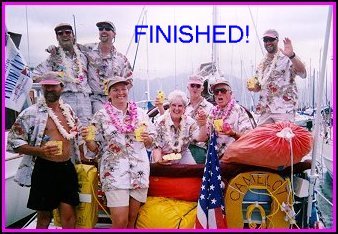
Eight people on a boat for 10 days on a boat seems like a tight fit, but figure that half are asleep or off-watch at any one time and thus not in your way. As for our Race results, I should preface them by quoting David Paul "We might not have won the race, but we won all the parties!!" I think we all did our best at both endeavors. We might not have carried bigger kites all the time, but we did make a respectable crossing in just over 10 days. We finished 4th in a class where 7 started, and 43 overall out of about 65 boats. We even "beat" Pywacket!! But most importantly, we didn't break anything or anybody! What we might have lost in speed we made up in fine dining. Example; At the halfway point Donna prepared a full-on Turkey Dinner complete with cranberries, mashed potatoes, gravy and wine! She fed us well from the moment we left until we made landfall. Salads, pudding, fruits, casseroles, scalloped potatoes, brownies.. you name it, she fixed it. We even had SPAM for one breakfast. The watch was also kept happy with power bars, M&M's, granola bars. We even had microwave-popped popcorn! This is a great place for me to express my thanks to the Shaw's for including me in their race program. Sure, I contributed, but if it wasn't for the fact that Camelot was racing over, I wouldn't have had this wonderful opportunity to sail across the Pacific for the first time. Thanks Howard, Craig and Donna!!!!! D.P. is what we call David Paul. He's been schooled on Lake Tahoe and in Santa Cruz on Moore-24's SC27's and other fast boats. Having a bunch of Santa Cruz ocean racing (Windjammers) and Swiftsures, etc.under his belt he led us to believe he was one of those Driver-Gods I spoke about earlier. I'd never met him before, and we've since become good friends. D.P. started things off on the right foot (or left, I forget) when he gave the all the crew NEW Rockport sailing shoes! Know those $89.00 numbers in the West Marine catalog? These were the same shoes! You gotta love a guy that does those "little things" on a boat that mean so much. When stuck on a boat together for almost 2 weeks it's wonderful to like the people you are sailing with. New shoes go a long way towards this end. Crew doesn't always get along, and I'm sure we've all heard stories of voyages that prove this point. Anyway, after we finished tight reaching we put up my bed (the kite), and D.P. started perfoming his magic at the wheel. He wiggled the boat around and down the swell, milking more speed than I thought was possible. It was great to see big numbers on the Fun-O-Meter. The down side was that we stayed roughly in the same place during his driving as he was all over the ocean getting to a swell over here, hitting the lip there... we actually thought about putting the pole on the wrong side of the kite as he was sailing by the lee so much! But seriously, his driving was really really good. I do think he even "willed" this boat up on a plane a few times. He was also a light sleeper and during a 3:00AM spinnaker douse I found him sitting next to me ready to help pull down the chute. "What a great guy! New shoes and now this!" I thought, as it was in the middle of his off-watch and at night. I thanked him rather graciously by giving him a big elbow to the eye during the take-down, resulting in a shinner that lasted well into Kaneohe Bay! I really should have done him a favor and knocked him out by hitting him harder so he could have gotten some sleep during the trip. D.P. was the resident word-smith with memorable treasures like "Pick em' up, reel 'em in, pass 'em by and move it on down the line" when refering to catching the boats ahead of us. Or, "I'm getting too much blood in my alchohol system" when sobering up from any party. And the philosophic "Life is all about timing and lubrication" where anyone's interpretation is welcome, or "How many people are up in the Stabbin' Cabin now?", probably because he thought the boat had too much weight forward. You see D.P. was always the one most concerned with our boat speed. At the halfway point we all had a beer, and when I opened mine and put the cap in my pocket he jumped all over me; "Throw the cap overboard you stupid &*@%$!. We need to lighten up this cow!" He'd act the same way if someone didn't completely flush and empty the head. So I started thowing his dirty underware overboard until he mellowed on the weight-thing. "Is keeping the boat light the reason you threw-up for two days, D.P.?" I'd ask him. You'd think we were on a Merit-25 or something. One night he came screaming out of bed telling us to ease the sheet, saying the boat felt bound-up and unable to move; "My bowels are cramped! I'm getting constipated, you shit-heads! I'm dying down here listening to you guys suffocate this boat!!!" Sure enough the sheet took close to 5 feet before the kite was correctly trimmed. Hey, I was making pop-corn. It was Al's and Howards fault, I'm sure! If you are like everyone else that asks
about this race, you want to know if I was scared! "It's a big ocean"
you say, and you are right, it is! So ok, I'll tell you about those
little things that go on in a race or voyage that might instill FEAR
in even the most seasoned mariner. Well, since we started a day or two
behind most of "Seas swamping and sinking the boat" - Waves sometimes slop over the boat, and get your cookies soggy, but seldom, if ever do they crash onto and swamp the boat filling the cockpit with water. Certainly not in the mild conditions that the Eastern Pacific finds itself at this time of year. Just as wings never fall off airplanes, waves never swamp and sink ships. Having said that, when they do, it's bad news. Fortunately people float better than they fly, so surviving a "loss of craft" at sea presents one with better odds at survival than losing your plane. Modern sailing has many lifesaving devices; 1) EPIRB's, 2) Radios, 3) the USCG, 4) Liferafts with EPIRBS, 5) Fellow boaters. An Emergency Position Indicating Radio Beacon sends a signal to a satelite for relay to a rescue receiving station, where the signal can be identified and located! In fact, one of the boats in this race saw a huge Coast Guard C-130 circling the boat one fine morning, hundreds of miles from shore. After they checked a crewmans seabag and turned off the accidently activated EPRIB the C-130 went away! These things work! So don't worry so much Mom! Onboard, someone getting hit in the head by the boom during an accidental jibe can ruin things in a big way, even ending in death. The dangerous act of trying to stop a jibing boom with your head has been tried before with little success. Wearing a helmet is a great idea. But keeping your head low, below the swinging arc of the boom is even better. Everyone is constanly aware of this danger, and a jibe-preventer is used as well. Of course toes get stubbed, fingers cut, etc. I think everyone is aware how far away emergency medical help is, and thus act accordingly. OK, on to scary things; Hitting a whale
is scary. Remote, but happens. Remember, a sailboat doesn't travel that
fast, and things happen slowly. Running Flying Fish -(Cheilopogon atrisignis); These things are incredible. They actually do Fly! I thought they were generously named, until I saw one "navigate" his or her way around the swell troughs that were running. They actually can defy gravity, soar, and turn at will! Needless to say I was impressed by these tropical little aerofish. One bigger flying fish soared over 75 yards while I watched it bank and turn. I think with a set of lungs these things could remain aloft. From my biology book:"Flying fish have corneas with flat facets, so they can see in both air and water. There is some evidence to suggest that they can choose landing sites. This might allow them to fly from food-poor to food-rich areas, but convincing evidence of this is lacking. There seems to be little doubt that escape from predators is the major purpose of flight, and this is why so many fly away from ships and boats which they perceive to be threatening." Now why they screw-up and end up landing on the boats may explain why they are still swimming in the ocean rather than writing computer code today. Our trip across was dictated by the daily weatherfax image. The objective of this race is to sail far enough below the Pacific High to get into the best wind, but not too far south and thus sail extra miles, and the weatherfax image shows the location of this high. Essentially the classical approach is to position yourself on the 1018 isobar which has the effect ofcombining; 1)Good winds, 2) Sailing the shortest distance to Hawaii and, 3) Sailing the fastest boatspeed to Hawaii. The optimum combination of the above three will result in a race winning boat, assuming the boat isn't a Nordic Tug and has decent speed off the wind. Surfing!! This is a term affectionately
used "Were there any Parties associated with
the Pacific Cup"? you ask? Is there any water in the Pacific Ocean?
Of course, and we started way ahead of the fleet! Life aboard was quite good after the first 2
days when the water stopped coming into my windward bunk. Our watch
(Howard, Al and myself) rotation consisted of one 6 hour watch (starting
at 0600), then 6 hours off, then 4 on, 4 off and then 4 on to complete
the cycle. It was then onto the next day which started with 6 hours
off. This way we rotated from "A" days to "B" days, then back to "A"
days again. Next time I'd like to try some other type of rotation that
rotates people in and out of watches, rather than two separate shifts
going alternatively on and off. I hardly ever was able to talk with
members of the other watch (Craig, D.P. & Tod). Which is too bad, because
it's those 3:00 AM conversations where you really find out about people,
their dreams, design the perfect sailboat, design and re-design the
perfect bikini, solve world hunger, develop a Unified Theory, etc. But
the watch system worked and I never felt too tired. Donna fed the crew
during This is Allan Staley (on the upper right), my watch buddy and TransPac Vet. He's known around the docks as The Owl! I'll always have this great memory of Allan driving during a 35 knot squall during the dead of night, with the kite up and his Owl-Glasses covered with water so he couldn't see shit. Talking about being on the edge!!! Since this boat steered less like a slot-car then we wished, one was left "pre-guessing" whether it was going to either round UP or round DOWN, both of which were rather unpleasent occurrences to say the least. But back to our hero in action; I'm sitting there eating gummy bears, ready to toss the spinnaker guy if/when we round down, laughing at "Mr. Intense", and telling him where the wind is coming from, as he can't see anything because of the rain on his glasses. He's cussing and driving totally by feel and instinct and my lame input... "You are too deep Allan!! Come up! You are going to Kill Us!" Imagine standing on the seat of a tricycle while steering it down the steepest hill in your town, while people hose you down with buckets of water in your face as you scream by... no brakes.. .. These squalls only last for about 15 minutes, but when you are on the helm, if feels like forever. Fortunately, they start weak, but get stronger with each squall that comes through, until you get these real wild rides that Al and Howard and myself would encounter. We took our turns at the wheel, and I remember my battles, with the wind blowing so hard I could barely hear Howard screaming at me!! (hehe) What a Blast!! Fishing: Our fishing efforts during the trip were weak, which explains why we caught no fish. For Tuna or Durado, all one needs to do is drag something behind the boat, preferably with a feather or two tied to the lure. Since boat racing and fishing are two distinctively different boating objectives, the fishing suffered. I personally don't think that a little lure can do much to slow a 12 ton sailboat. None the less, since I work for Luhr Jensen & Sons, a fishing lure manufacture in Hood River, Oregon, I brought plenty of gear. In fact, if you awoke in Alameda, and saw a huge Mahi-Mahi lure hanging from your life line, it was me, the Good Pherry Fisherman who left it. And no, I wan't trying to handicap the fleet! Of course there was "Arturo-The Aqua Boy" who toward the end of the race had nothing but a PowerBar or two left to eat were merely fishing for subsistence. At one point they had a fish up to the boat.... before it jumped off the hook! (*#@!$&^)! My responsibility with your fishing ends when the fish gets on the hook.... it's up to you to get it off the hook and into your boat. So if you find yourself with a ride for the Pacific Cup-2000, make plenty of room in your memory banks for storage. It's a real trip, and you may not be the same afterwards. It's a fortunate few who sail a boat to Hawaii, and racing keeps it exciting. Get to know as many boats and people involved prior to sailing out the gate. Much of the fun is tracking various boats and friends across during the daily morning role call. Everyone is a friend at the Kaneohe Y.C. at the finish, so get a jump on it and start buying drinks for others at the Bon Voyage party, or earlier. Prepare yourself by staying up late and getting up early. Take 3 hour naps during the day. Buy two books, but save them for the trip. Buy some stock in the company that makes zip-lock bags. Call me when your fore-deck crew decides to; enroll in summer school/have a baby/buy a house/change his/her mind. (note: I will be on the SC50 "Anomaly" this year out of Seattle) But most of all, have a great time, wear a hat, have fun and use your sunscreen. FastCounter by LinkExchange |
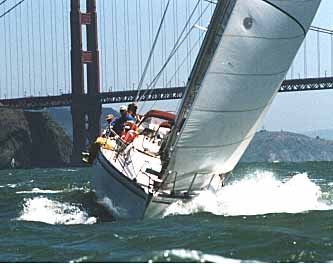 first start for
the smallest boats is on June 29th. Additional starts for faster boats will
be on subsequent days, and the last start will be on July 2nd. If the
Weather is typical, most boats should finish the race between July 11th
and 14th.
first start for
the smallest boats is on June 29th. Additional starts for faster boats will
be on subsequent days, and the last start will be on July 2nd. If the
Weather is typical, most boats should finish the race between July 11th
and 14th.
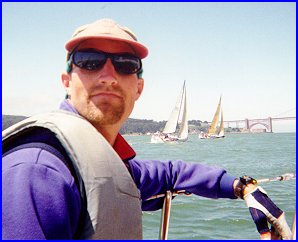 crew
position on a boat for this race all winter, and living in Hood River
(Oregon), I'm not anywhere near the hub of ocean racing. (B.T.W., here
is my
crew
position on a boat for this race all winter, and living in Hood River
(Oregon), I'm not anywhere near the hub of ocean racing. (B.T.W., here
is my 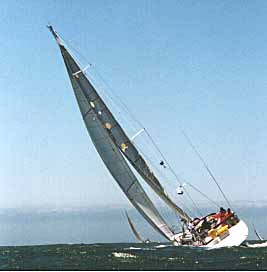 As
I sloshed to my bunk, and hit it with a splash, the part of the race
spent running downwind dressed in nothing but shorts (or nothing) was
just a distant rumor.
As
I sloshed to my bunk, and hit it with a splash, the part of the race
spent running downwind dressed in nothing but shorts (or nothing) was
just a distant rumor.
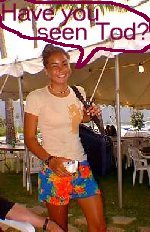 the fleet, we were naturally afraid that everyone would get to the bar
in Kanehoe first and deplete the rum stores and get all the girls, but
as we started making time up on these boats, those fears subsided. On
a race such as this, the only real unsafe condition is finding yourself
overboard as your boat silently sails to the horizon faster than you
can swim to it. THAT's why one wears a safety chest-harness and a teather
that connects the harness (and thus you) to the boat when on deck, and
especially at night... so IF you do fall off the ship, they can retrieve
your body at the crew's leasure. I personally like a harness teather
line to be about 3 inches long so I don't fall too far, or get pulled
through the water at 10 or so knots to my death. Of course, to be able
to move around a boat (which is what you do when sailing) your teather
needs to be much longer. Mine is about 5 feet long.
the fleet, we were naturally afraid that everyone would get to the bar
in Kanehoe first and deplete the rum stores and get all the girls, but
as we started making time up on these boats, those fears subsided. On
a race such as this, the only real unsafe condition is finding yourself
overboard as your boat silently sails to the horizon faster than you
can swim to it. THAT's why one wears a safety chest-harness and a teather
that connects the harness (and thus you) to the boat when on deck, and
especially at night... so IF you do fall off the ship, they can retrieve
your body at the crew's leasure. I personally like a harness teather
line to be about 3 inches long so I don't fall too far, or get pulled
through the water at 10 or so knots to my death. Of course, to be able
to move around a boat (which is what you do when sailing) your teather
needs to be much longer. Mine is about 5 feet long.
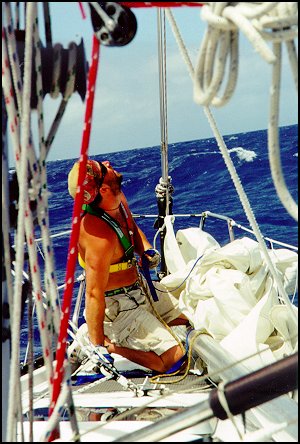 out
of M&M's is a scary! Slipping on a squid and jamming your toe under
the Spinnaker pole is also a scary thought. Running into ships would
ruin one's day, but that is why we always have a watchman or lookout.
Actually with weather faxes, radios, GPS's, RADAR and my safety strobe-light
and whistle, there really is no need to be caught unprepared and thus
get frightened. I'd rather be in the middle of the ocean at 3:00AM than
in most large cities. Makes me think of a quote I read the other day;
"Terror is the absence of humor, and Humor is the absence of terror".
So I guess the idea is to be prepared, have faith in your abilities,
and keep in good spirits! You can't be scared when you are laughing
can you? Well maybe, but at least you don't look scared.
out
of M&M's is a scary! Slipping on a squid and jamming your toe under
the Spinnaker pole is also a scary thought. Running into ships would
ruin one's day, but that is why we always have a watchman or lookout.
Actually with weather faxes, radios, GPS's, RADAR and my safety strobe-light
and whistle, there really is no need to be caught unprepared and thus
get frightened. I'd rather be in the middle of the ocean at 3:00AM than
in most large cities. Makes me think of a quote I read the other day;
"Terror is the absence of humor, and Humor is the absence of terror".
So I guess the idea is to be prepared, have faith in your abilities,
and keep in good spirits! You can't be scared when you are laughing
can you? Well maybe, but at least you don't look scared.
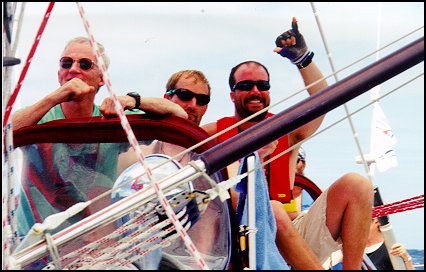 to describe the last 1000 miles of the race where the boats are running
downwind with the predominant swell and wind-wave direction. Boats that
are both fast and light enough can essentially ride these waves all
the way to the Islands! The wind provides the boats with enough speed
to position it correctly on the face of a swell, which then gently lifts
the stern which starts the boat sliding or surfing down the face of
the swell. When this happens the boat will accelerate, the crew will
start screaming, and the speedo hopefully gets pressed gently, yet firmly
against the high-limit peg. Boats that can achieve this level of fun
and seamanship usually end up first at the finish line! Boats that can
do this are called
to describe the last 1000 miles of the race where the boats are running
downwind with the predominant swell and wind-wave direction. Boats that
are both fast and light enough can essentially ride these waves all
the way to the Islands! The wind provides the boats with enough speed
to position it correctly on the face of a swell, which then gently lifts
the stern which starts the boat sliding or surfing down the face of
the swell. When this happens the boat will accelerate, the crew will
start screaming, and the speedo hopefully gets pressed gently, yet firmly
against the high-limit peg. Boats that can achieve this level of fun
and seamanship usually end up first at the finish line! Boats that can
do this are called 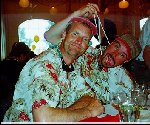 The
first and only stateside party was the Bon Voyage party held at Scott's
at Jack London Square, across the Alameda Estuary from where the majority
of the Pacific Cup fleet was staged. This party was the first where
all the crew from the boats entered could assemble, meet each other,
and wear their Boat Shirts. These shirts were a boats identity onshore.
If you passed out wearing your boat shirt, someone would either wake
you up to buy you a drink, or drag you back to your ship. Kinda like
the Old Navy I'm told. Anyway, after a night of wildness, Tod, Andy
from Arturo-The Aqua Boy, and I naturally decided that the prudent method
of getting back to our boat was to swim across the estuary, rather than
drive back. We swim and sail in big Columbia River Gorge water conditions,
so this was a piece of cake. I mean the water is warmer, and we floated
better in the salt water, so why not, right? In fact we discussed the
pro's and con's for a good three seconds before we started climbing
fences and jumped in. Two things that we thought were funny was the
casual "Hello There" wave from a passing motor boat while in the swimming
the middle of the estuary (was it the
The
first and only stateside party was the Bon Voyage party held at Scott's
at Jack London Square, across the Alameda Estuary from where the majority
of the Pacific Cup fleet was staged. This party was the first where
all the crew from the boats entered could assemble, meet each other,
and wear their Boat Shirts. These shirts were a boats identity onshore.
If you passed out wearing your boat shirt, someone would either wake
you up to buy you a drink, or drag you back to your ship. Kinda like
the Old Navy I'm told. Anyway, after a night of wildness, Tod, Andy
from Arturo-The Aqua Boy, and I naturally decided that the prudent method
of getting back to our boat was to swim across the estuary, rather than
drive back. We swim and sail in big Columbia River Gorge water conditions,
so this was a piece of cake. I mean the water is warmer, and we floated
better in the salt water, so why not, right? In fact we discussed the
pro's and con's for a good three seconds before we started climbing
fences and jumped in. Two things that we thought were funny was the
casual "Hello There" wave from a passing motor boat while in the swimming
the middle of the estuary (was it the 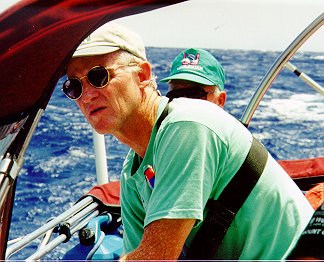 these
watch changes, which made her job easier. One of the best things Donna
did, other than keep us well fed, was keeping the microwave oven/locker
full of goodies! Power Bars, granola bars, candy, left-overs... if you
were hungry, you could find something in that "White-Box" that would
satisfy. I know I hit the white-box hard many times, if only to be doing
something to stay awake. The chocolate-covered goodies were my favorite.
I never knew what they were, because it was always at night when I stole
down to grab a goodie-bar.
these
watch changes, which made her job easier. One of the best things Donna
did, other than keep us well fed, was keeping the microwave oven/locker
full of goodies! Power Bars, granola bars, candy, left-overs... if you
were hungry, you could find something in that "White-Box" that would
satisfy. I know I hit the white-box hard many times, if only to be doing
something to stay awake. The chocolate-covered goodies were my favorite.
I never knew what they were, because it was always at night when I stole
down to grab a goodie-bar.